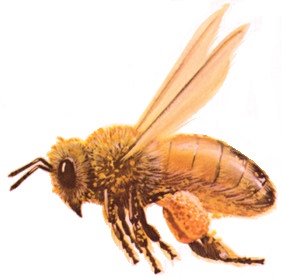
Learning by Bees

Grades: 9-12
Essential Skills: Science
Duration: 2 class periods
OVERVIEW
Students investigate learning by bees as related to vision and foraging behavior.
Preparation
Other Materials:
Information Sheets:
Activity Sheets:
Lesson Plan
Introduction
Note: Some students may be concerned that the live honey bees in this experiment will sting. Remind them that foraging honey bees are not likely to sting unless provoked. Suggest that the students wear light colors and don't use scents on the day of the experiment. If a bee comes too close, tell them not swat or flail their arms. It is a good idea to find out if any of your students are allergic to bee stings. They might want to take part in the data analysis and discussions, but notin the data collection process.
Activity 1 Training bees (45 minutes)
This is an outdoor activity and needs to be in an area where there are active honey bees gathering food or water. Set up a table outside (it needs to be durable since this experiment will go on for several days). Have the students prepare at least three different concentrations of sugar water (such as 50%, 25%, and 10% or 0%). Also gather some fake flowers of different colors, or make them from construction paper or colored plastic. Make sure the flowers are large enough so that whatever is used to hold the sugar water (the lid to a large mayonnaise jar or a petri dish, for example) will fit on top of the flower but still allow the pe tals to show at least an inch around the edge.
Set three dishes with different concentrations of sugar water on three different colored flowers as far apart as possible on the table. Wait for bees to find the sugar water. As the bees begin to find the dishes, have the students observe which sugar concentrations they prefer. Make sure that the dishes stay filled with the solution. The students may need to refill the lid a few times during the day. After a day or so, switch the favored solution to another colored flower on the table. What do the bees do? Can they find the solution that they liked best?
Next time have the students try keeping the dishes in the same place, but switching the flower colors underneath them. Discuss how the bees are finding their nectar. Another variation on this is to remove the colored flowers and instead place a small vial with a screen top and fill it with a scent. Ask the students to place a different scent next to each sugar solution. If they have all the solutions the same concentration, they can test whi ch scents the bees like most. Use natural scents from flowers (such as orange blossoms) or use extracts like those that you can buy at the grocery store (orange, vanilla, peppermint, but don't use banana, lemon or citronella).
This type of experiment may be used to examine how honey bees perceive colors and shapes. For example, train the bees so that two yellow flowers have 0% sugar baits and one red flower has 25% sugar water bait. Then switch the yellow flowers with black flowers of the same shape. Can the bees still find the red flower?
Conclusion
Have the students write a laboratory report discussing their findings.
Additions
(for understanding only, not to be tested)
Bibliography:
Insects and Flowers: The Biology of a Partnership, by F.G. Barth. Published by Princeton University
Press, Princeton, NJ, 1985.
The Clover & The Bee, A Book of Pollination, by A.O.T. Dowden, published by Harper Collins
Publ., N.Y., 1990.
Roses Red, Violets Blue: Why Flowers Have Colors, by S. A. Johnson and Y. Sato. Published by
Lerner, M.N., 1991.
The Story of Pollination, by B.J.D. Meeuse. Published by the Ronald Press Company, N.Y., 1961.
The Sex Life of Flowers, by B. Meeuse and S. Morris. Facts on File, N.Y., 1984.
The Pollination of Flowers, by Michael Proctor and Peter Yeo. Published by Collins, London, 1973.